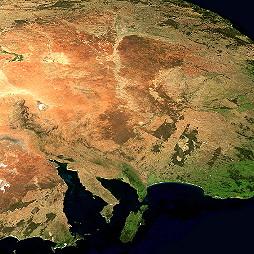Posted 22 May 2009

Satellite image overlooking the Murray-Darling Basin (NASA Worldwind)
The drought affecting Australia is far worse than previously thought with satellite images The drought affecting Australia is far worse than previously thought with satellite images revealing the Murray-Darling Basin has lost 200 cubic kilometres of water over the last six years - the equivalent of 400 Sydney Harbours.
The research, conducted jointly by Dr Marc Leblanc of the School of Earth and Environmental Sciences at James Cook University and by Dr Paul Tregoning of the Research School of Earth Sciences at The Australian National University, was published in the journal, Water Resources Research.
Their study used data from the GRACE (Gravity Recovery and Climate Experiment) space gravity mission to assess the amount of surface water, soil water and groundwater losses in the Murray-Darling Basin.
Drs Leblanc and Tregoning said that the GRACE data and the collaboration between the two universities and a French team from the Centre Nationale de la Recherche Scientifique allowed the researchers important new ways of assessing the state of the drought in the Murray-Darling Basin.
"Droughts affect more people globally than any other natural hazard. There is a real need for better tools to monitor droughts and new satellites have an important contribution to play here," said Dr Tregoning. "Finally, changes in total water storage can be quantified through the use of observations of the Earth from space."
"Water accounting requires an integrated approach," added Dr Leblanc. "JCU and ANU are jointly developing new techniques for integrated water monitoring. To date, a major challenge in drought studies has been to quantify total water deficit across vast areas. This joint study shows that the GRACE mission can be used to quantify this total water deficit during droughts at the basin scale."
"From 2000 to 2008 the basin lost about 200 km3 of water in total, that's 200,000 GL, the equivalent of eight Port Philip Bays or 400 Sydney Harbours. The focus of typical attention - surface water - represents only six per cent of this total water loss. About half of the water loss is groundwater, and the rest is moisture in the soil," said Dr Leblanc.
"Across the basin, most of the surface water and soil moisture is lost rapidly in the first two years after the onset of the drought. But the basin continues to lose vast quantities of water, long after most water at the land surface has dried up. That is, the groundwater drought continues to worsen.
"The severe drought in the Murray-Darling Basin is a stark reminder of the sort of major water crisis we could face under climate change," said Dr Leblanc.
The research work is funded through a Discovery Grant from the Australian Research Council.
Source: James Cook University News
Links:

Professor Andy Baker features in American Water Resources Association ‘Water Resources Impact’, September 2020 edition.

The Connected Waters Initiative (CWI) is pleased to welcome Taylor Coyne to its network as a postgraduate researcher. If you’re engaged in research at a postgraduate level, and you’re interested in joining the CWI network, get in touch! The CWI network includes multidisciplinary researchers across the Schools of Engineering, Sciences, Humanities and Languages and Law.

The Grand Challenge on Rapid Urbanisation will establish Think Deep Australia, led by Dr Marilu Melo Zurita, to explore how we can use our urban underground spaces for community benefit.

On the 21 August 2020, CWI researchers made a submission to the National Water Reform Inquiry, identifying priority areas and making a number of recommendations as to how to achieve a sustainable groundwater future for Australia.

Results published from a research project between the Land Development Department (LDD) Thailand and UNSW has demonstrated how 2-dimensional mapping can be used to understand soil salinity adjacent to a earthen canal in north east Thailand (Khongnawang et al. 2020).